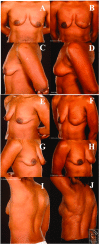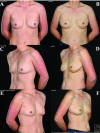Postmastectomy Breast Reconstruction With the Totally Autologous Latissimus Dorsi Flap in the Thin, Small-Breasted Woman: Give It More Thought!
- PMID: 29564032
- PMCID: PMC5838613
Postmastectomy Breast Reconstruction With the Totally Autologous Latissimus Dorsi Flap in the Thin, Small-Breasted Woman: Give It More Thought!
Abstract
Introduction: Thin women have fewer autologous tissue breast reconstructive options than their higher body mass index counterparts-due to a lack of adequate donor sites. They are therefore usually offered expander/implant techniques. The total autologous latissimus dorsi flap is generally used in "well-padded" individuals, as they have enough fat on their back on which a completely autologous reconstruction could be based. When implant-based reconstruction is contraindicated (for instance due to planned adjuvant radiotherapy) or unacceptable to the patient, the total autologous latissimus dorsi flap can provide adequate tissue volume by utilizing the additional back fat deposits even in the thin, small-breasted patient. This option is often overlooked by many surgeons. Our case series assesses indications and patient and surgeon satisfaction with the cosmetic outcome of this technique. Methods: The oncological and clinical details of 6 patients with breast cancer who underwent total autologous latissimus dorsi myocutaneous flap immediate breast reconstruction by a single surgeon over an 8-year period were reviewed. An objective assessment of satisfaction with the cosmetic result was made by whether any additional surgical interventions (ipsilateral fat grafting/implant augmentation or contralateral liposuction/ reduction) were needed or not. A subjective assessment of breast symmetry by the surgeon using photographic records was also undertaken. The aesthetic outcomes were also objectively quantified using the BCCT.core software, initially developed for assessing the results of breast conservation surgery. Results: All 6 patients had small breasts and a low or normal body mass index. The mastectomies were performed for invasive carcinoma (n = 3) and extensive high-grade ductal carcinoma in situ (n = 3). Four had axillary surgery (2 sentinel lymph node biopsies and 2 axillary clearances), and 3 received adjuvant radiotherapy. All were happy with their reconstructive outcomes, and none suffered major postoperative complications or disease recurrence. None requested or needed any subsequent ipsilateral adjustment or contralateral symmetrizing procedures. Subjectively, the reconstructions provided acceptable or excellent cosmetic results. The cosmetic results were categorized as excellent or good on the BCCT.core scoring system. Conclusion: This underutilized method of totally autologous breast reconstruction in thinner patients with lower body mass indexes yielded good, well-accepted cosmetic results without recourse to adjustment procedures, contralateral balancing surgery, or complex microvascular surgery. We recommend that the total autologous latissimus dorsi flap should be given more consideration when planning immediate breast reconstruction in this challenging group of thin, small-breasted patients.
Keywords: autologous reconstruction; breast cancer; breast reconstruction; latissimus dorsi; mastectomy.
Figures





Similar articles
-
Staged breast reconstruction with saline-filled implants in the irradiated breast: recent trends and therapeutic implications.Plast Reconstr Surg. 2000 Mar;105(3):930-42. doi: 10.1097/00006534-200003000-00016. Plast Reconstr Surg. 2000. PMID: 10724252
-
Autologous breast reconstruction with the extended latissimus dorsi flap.Plast Reconstr Surg. 2002 Sep 1;110(3):751-9; discussion 760-1. doi: 10.1097/00006534-200209010-00005. Plast Reconstr Surg. 2002. PMID: 12172134
-
Outcomes of Fat-Augmented Latissimus Dorsi (FALD) Flap Versus Implant-Based Latissimus Dorsi Flap for Delayed Post-radiation Breast Reconstruction.Aesthetic Plast Surg. 2018 Jun;42(3):692-701. doi: 10.1007/s00266-018-1081-6. Epub 2018 Jan 25. Aesthetic Plast Surg. 2018. PMID: 29372268
-
Indications and Controversies for Complete and Implant-Enhanced Latissimus Dorsi Breast Reconstructions.Clin Plast Surg. 2018 Jan;45(1):75-81. doi: 10.1016/j.cps.2017.08.006. Epub 2017 Sep 23. Clin Plast Surg. 2018. PMID: 29080662 Review.
-
Breast reconstruction with latissimus dorsi flap: a comprehensive review and case series.Ann Transl Med. 2023 Aug 30;11(10):355. doi: 10.21037/atm-23-469. Epub 2023 May 24. Ann Transl Med. 2023. PMID: 37675333 Free PMC article. Review.
Cited by
-
An Algorithm for Selecting Buoy Skin Paddle Design for Flap Monitoring in Total Autologous Breast Reconstruction After Nipple-Sparing Mastectomy.Cureus. 2023 Jan 6;15(1):e33443. doi: 10.7759/cureus.33443. eCollection 2023 Jan. Cureus. 2023. PMID: 36751161 Free PMC article.
-
Acellular Dermal Matrix Performance Compared with Latissimus Dorsi Myocutaneous Flap in Expander-Based Breast Reconstruction.Plast Reconstr Surg Glob Open. 2019 Sep 30;7(9):e2414. doi: 10.1097/GOX.0000000000002414. eCollection 2019 Sep. Plast Reconstr Surg Glob Open. 2019. PMID: 31942389 Free PMC article.
References
-
- Malata CM, McIntosh SA, Purushotham AD. Immediate breast reconstruction after mastectomy. Br J Surg. 2000;87(11):1455–72. - PubMed
-
- Mehrara BJ, Ho AY. Breast reconstruction. In: Harris JR, Lippman ME, Morrow M, Osborne CK, editors. Diseases of the Breast. 5th ed. Philadelphia, PA: Lippincott Williams & Wilkins; 2014. pp. 536–52.
LinkOut - more resources
Full Text Sources
